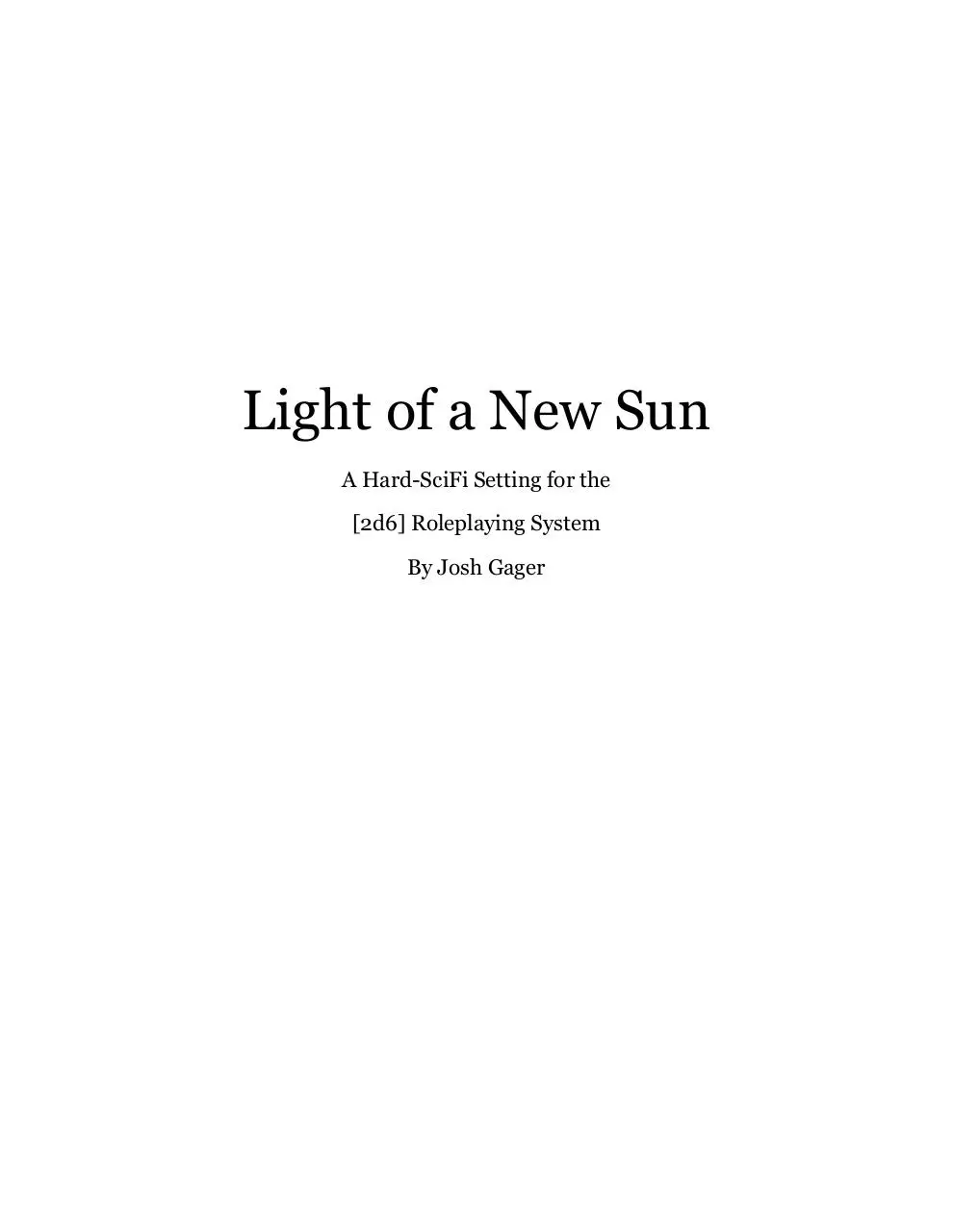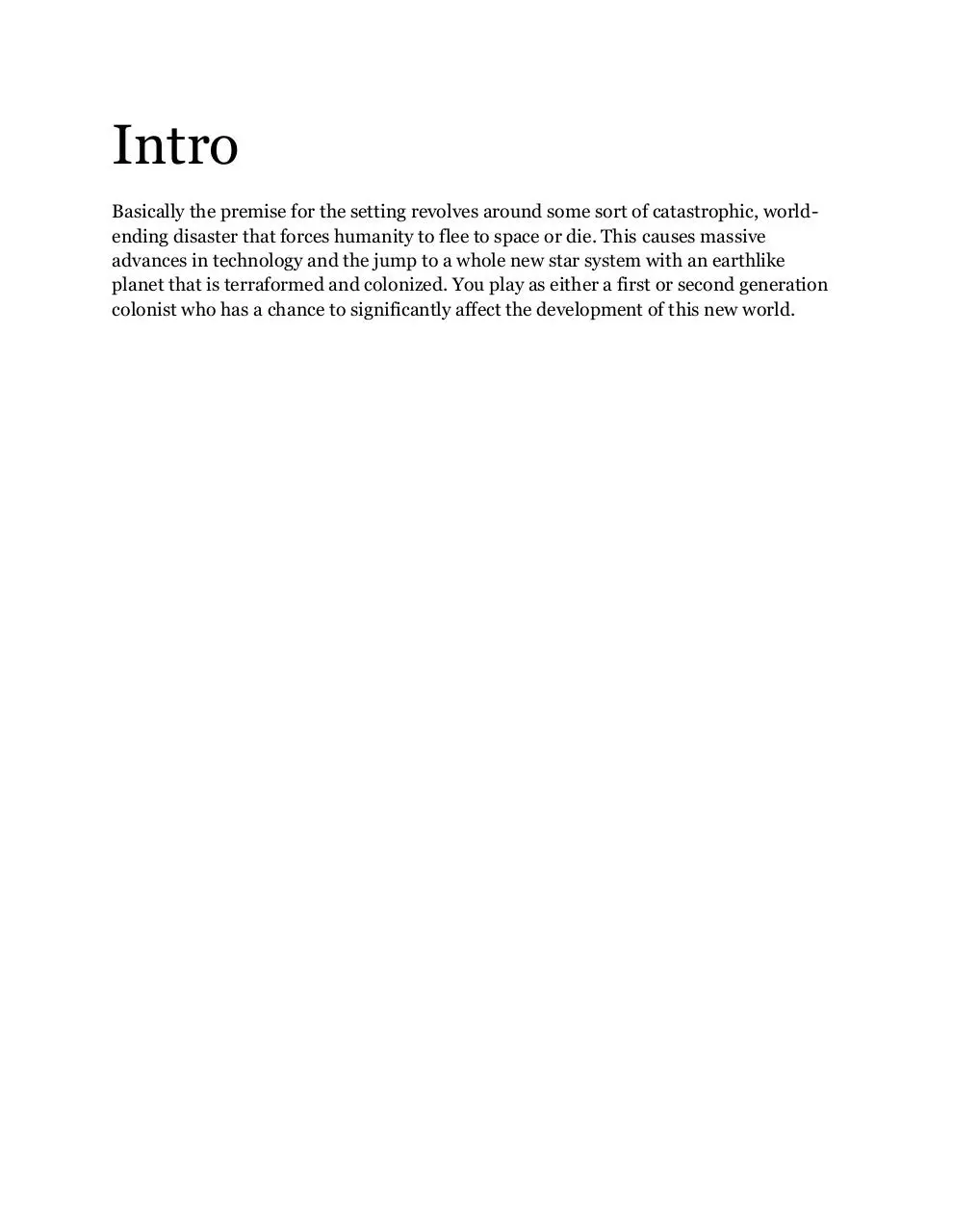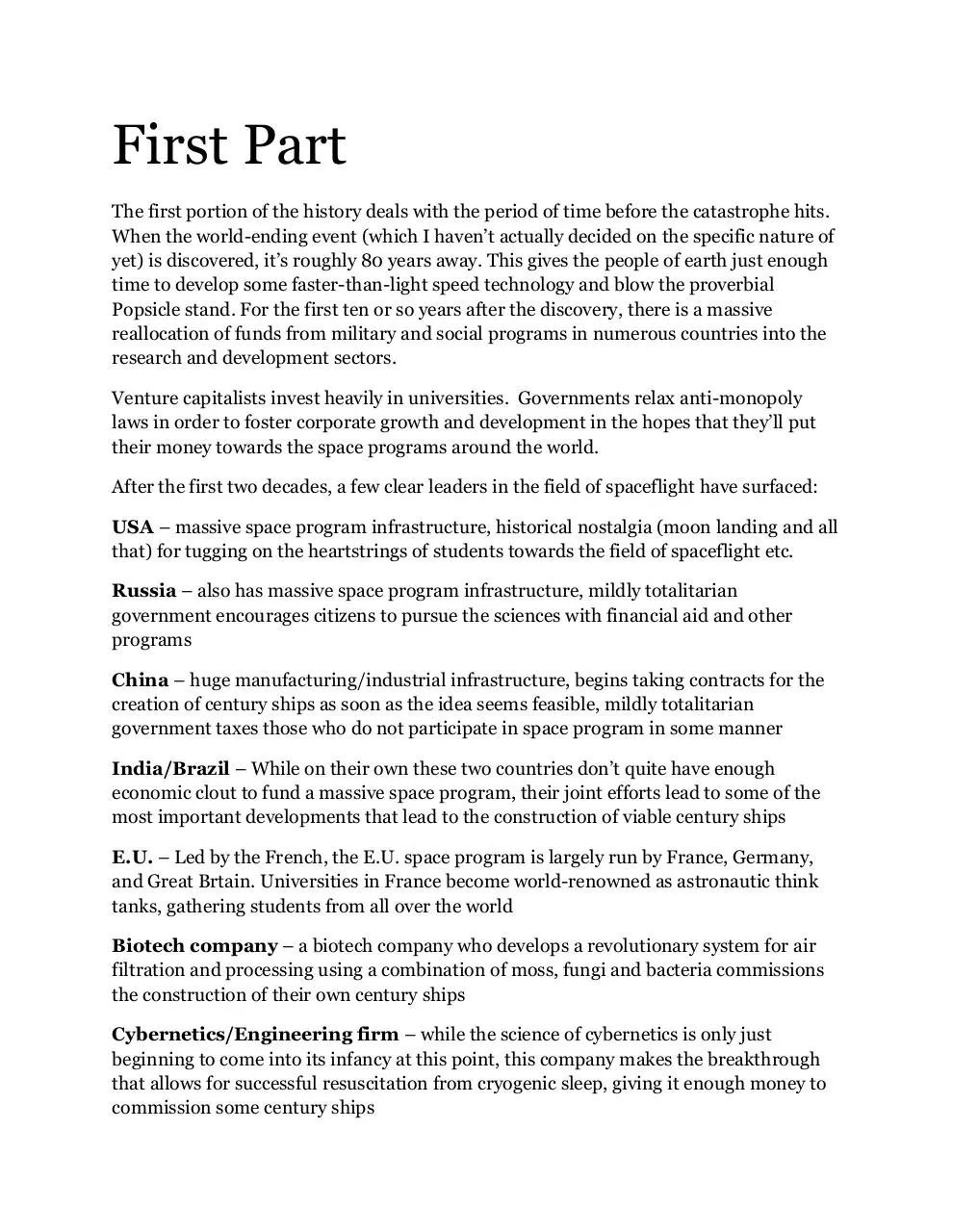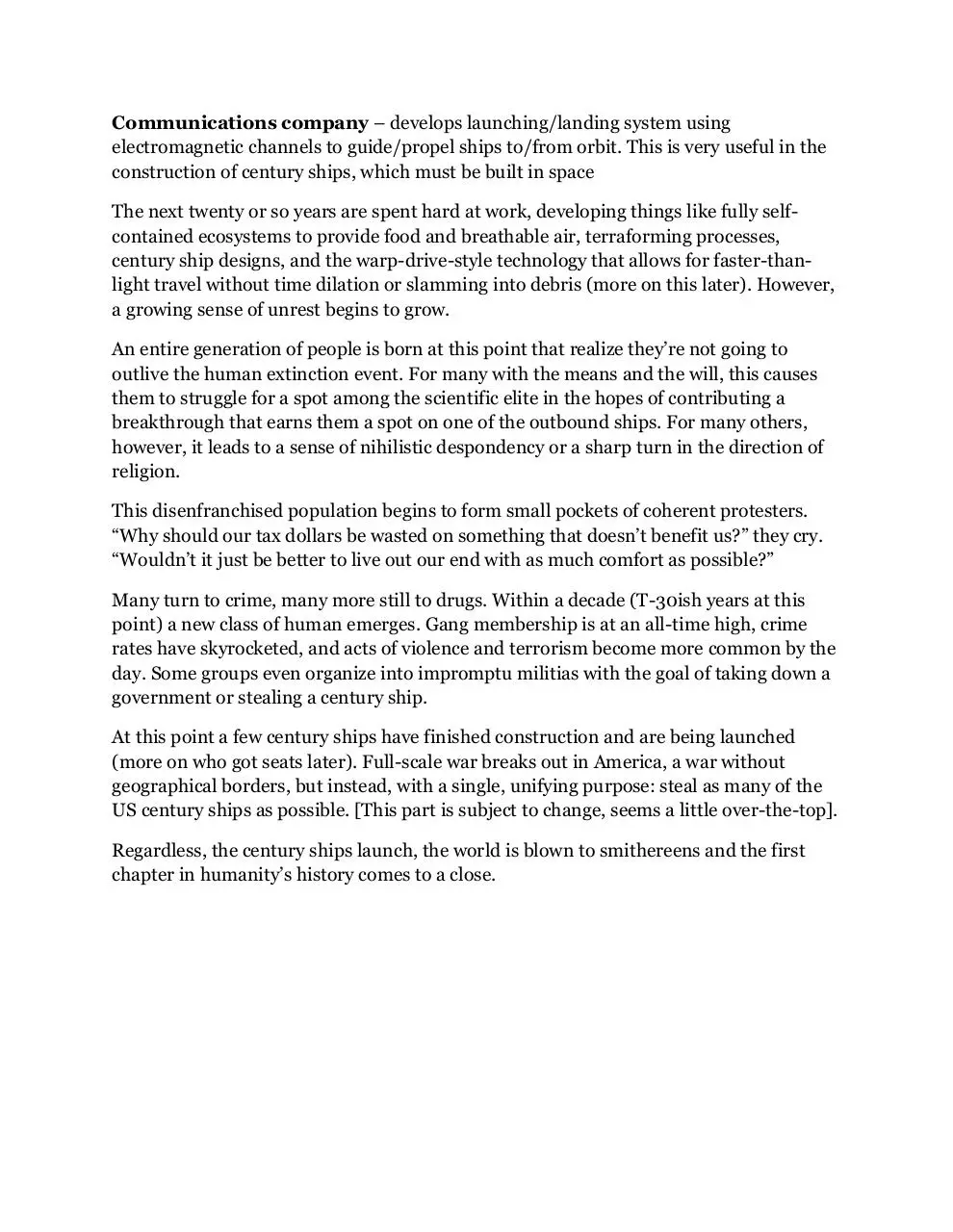Light of a New Sun (PDF)
File information
Author: Gager, Joshua D.
This PDF 1.5 document has been generated by Microsoft® Word 2010, and has been sent on pdf-archive.com on 17/11/2012 at 03:42, from IP address 150.250.x.x.
The current document download page has been viewed 961 times.
File size: 323.21 KB (12 pages).
Privacy: public file





File preview
Light of a New Sun
A Hard-SciFi Setting for the
[2d6] Roleplaying System
By Josh Gager
Intro
Basically the premise for the setting revolves around some sort of catastrophic, worldending disaster that forces humanity to flee to space or die. This causes massive
advances in technology and the jump to a whole new star system with an earthlike
planet that is terraformed and colonized. You play as either a first or second generation
colonist who has a chance to significantly affect the development of this new world.
History
First Part
The first portion of the history deals with the period of time before the catastrophe hits.
When the world-ending event (which I haven’t actually decided on the specific nature of
yet) is discovered, it’s roughly 80 years away. This gives the people of earth just enough
time to develop some faster-than-light speed technology and blow the proverbial
Popsicle stand. For the first ten or so years after the discovery, there is a massive
reallocation of funds from military and social programs in numerous countries into the
research and development sectors.
Venture capitalists invest heavily in universities. Governments relax anti-monopoly
laws in order to foster corporate growth and development in the hopes that they’ll put
their money towards the space programs around the world.
After the first two decades, a few clear leaders in the field of spaceflight have surfaced:
USA – massive space program infrastructure, historical nostalgia (moon landing and all
that) for tugging on the heartstrings of students towards the field of spaceflight etc.
Russia – also has massive space program infrastructure, mildly totalitarian
government encourages citizens to pursue the sciences with financial aid and other
programs
China – huge manufacturing/industrial infrastructure, begins taking contracts for the
creation of century ships as soon as the idea seems feasible, mildly totalitarian
government taxes those who do not participate in space program in some manner
India/Brazil – While on their own these two countries don’t quite have enough
economic clout to fund a massive space program, their joint efforts lead to some of the
most important developments that lead to the construction of viable century ships
E.U. – Led by the French, the E.U. space program is largely run by France, Germany,
and Great Brtain. Universities in France become world-renowned as astronautic think
tanks, gathering students from all over the world
Biotech company – a biotech company who develops a revolutionary system for air
filtration and processing using a combination of moss, fungi and bacteria commissions
the construction of their own century ships
Cybernetics/Engineering firm – while the science of cybernetics is only just
beginning to come into its infancy at this point, this company makes the breakthrough
that allows for successful resuscitation from cryogenic sleep, giving it enough money to
commission some century ships
Communications company – develops launching/landing system using
electromagnetic channels to guide/propel ships to/from orbit. This is very useful in the
construction of century ships, which must be built in space
The next twenty or so years are spent hard at work, developing things like fully selfcontained ecosystems to provide food and breathable air, terraforming processes,
century ship designs, and the warp-drive-style technology that allows for faster-thanlight travel without time dilation or slamming into debris (more on this later). However,
a growing sense of unrest begins to grow.
An entire generation of people is born at this point that realize they’re not going to
outlive the human extinction event. For many with the means and the will, this causes
them to struggle for a spot among the scientific elite in the hopes of contributing a
breakthrough that earns them a spot on one of the outbound ships. For many others,
however, it leads to a sense of nihilistic despondency or a sharp turn in the direction of
religion.
This disenfranchised population begins to form small pockets of coherent protesters.
“Why should our tax dollars be wasted on something that doesn’t benefit us?” they cry.
“Wouldn’t it just be better to live out our end with as much comfort as possible?”
Many turn to crime, many more still to drugs. Within a decade (T-30ish years at this
point) a new class of human emerges. Gang membership is at an all-time high, crime
rates have skyrocketed, and acts of violence and terrorism become more common by the
day. Some groups even organize into impromptu militias with the goal of taking down a
government or stealing a century ship.
At this point a few century ships have finished construction and are being launched
(more on who got seats later). Full-scale war breaks out in America, a war without
geographical borders, but instead, with a single, unifying purpose: steal as many of the
US century ships as possible. [This part is subject to change, seems a little over-the-top].
Regardless, the century ships launch, the world is blown to smithereens and the first
chapter in humanity’s history comes to a close.
Second Part
The second portion of the history deals with the time spent on the century ships, roughly
a 300-year journey. Not all countries chose to use century ships. The U.S. in particular
chose to use cryogenics to preserve their passengers. For those that did choose to keep a
living, changing society for the next 300 years, things got pretty crazy pretty fast.
For starters, a larger portion of the people in the century ships were educated and had
backgrounds in some form of science or trade (see “who got tickets to the new earth”).
Because of this, technology progressed at a fast pace within the individual ships. The
ships, however, were cut off from one another. This caused some technologies to be
developed more than once, independently, which led to patent lawsuits later on.
Shortly after launch, a generation was born that didn’t choose to go on this rickety lastchance flight to a new solar system. This caused, in some cases, enmity between parent
and child. What the parent saw as an opportunity for survival, the child saw as a prison
sentence for themselves and their progeny, who would never set foot on the new world.
At first there was a rise in crime and violence, but this eventually subsided when, at least
on most of the ships, a specialized field of psychology was developed to help people
cope.
In many cases, religion had all but died out with the first generation, but was then
picked up by the second generation as a defense mechanism against the depressing
thought of never seeing either end of the voyage. This caused a number of new religions
to spring up [I’ll probably do a more thorough write-up on religions later].
Many cultures’ art adapted a heavy element of utilitarianism out of necessity. After all,
on these ships, supplies are finite and decorations without a functional purpose were
sparse. Many artists chose to produce crafts or ornate tools, which ushered in an era of
fusion between design and function on a large scale.
In some ships, there were revolts, where one group didn’t like the way things were run.
One Chinese ship, for instance, split on the subject of resource spending at the other end
of the journey, with military spending on one side and agricultural spending on the
other.
Some of the ships were simply destroyed by these internal struggles, their hulls
breached or their delicately balanced ecosystems tainted by war or sabotage.
Finally, however, the ships did make it.
Third Part
The third, and final part of the saga is the arrival and colonization of the new planet
[name to be determined]. In the early years, orbits and communications between ships
are established, what terraforming has already been going on is supplemented and
tweaked, and tense peace is tested daily.
Many countries, eager to be first on the ground, send out colonies too early and lose
thousands to the harsh ravages of bad soil, water, or atmosphere.
Eventually the planet is mostly habitable and colonies are formed. While there are some
minor skirmishes here and there, there is no outright war, since there is much more
land than there are people at this point.
The century ships themselves (once they’ve landed) become most of the larger cities,
with growth spreading from their unlocked doors. In some environments growth doesn’t
spread too far because of climate or terrain, but in others (as is the case with China and
the E.U., vast stretches of land are colonized and turned into fertile fields that feed the
ever-swelling population.
Here is where you stand, on the brink of a new age of exploration, travel, trade, and
political intrigue. You are among the first to set foot on this new planet. How will you
make your mark?
Geography
This map is extremely rough at the moment. I inked it to give myself something to work
with. I have a general idea of where different societies are going to have landed, but this
is subject to change. Also I have to fix the poles, which I realized too late are physically
impossible.
Tech/Items
Antigravity? (hovercars would be super cool, but I need to make sure the
disconnected feel of the outlying colonies isn’t lost)
Lasers (like glorified stunguns/cutting tools)
Short-range spacecraft
Cryogenics
Terraforming
Instantaneous Communication?
Artificial/Synthetic Wood and meat?
H2 cells for power
“Warp”-ish drive for engine
Nutrient Cycling systems
Railgun launchers for ships
Watersplitter for breathing underwater (can save H2 for fuel if get attachment)
BioPhotoVoltaic cells?
Genemodding/Cybernetics:
Gills
Chitin plates/Armor
Night vision
Hypersensitive nose
Eye/hair/skin color
Feathers/scales etc.
Singer’s voice etc.
Anticancer contract with biotech comp.
Chloro/chromoplasts
“memory” slot wired into brain (no more than 3 at a time or permanent INT
dmg)*
+STR/DEX/TOUGH/AGI limb/organ
Prehensile tail
Digital eyes (heat/night vision)
Datalink in brain?
Replacement organ (synthetic or grown)
*these would allow skill bonuses/talents while they were plugged in
Talents
Politics
Societies
Download Light of a New Sun
Light of a New Sun.pdf (PDF, 323.21 KB)
Download PDF
Share this file on social networks
Link to this page
Permanent link
Use the permanent link to the download page to share your document on Facebook, Twitter, LinkedIn, or directly with a contact by e-Mail, Messenger, Whatsapp, Line..
Short link
Use the short link to share your document on Twitter or by text message (SMS)
HTML Code
Copy the following HTML code to share your document on a Website or Blog
QR Code to this page

This file has been shared publicly by a user of PDF Archive.
Document ID: 0000063124.